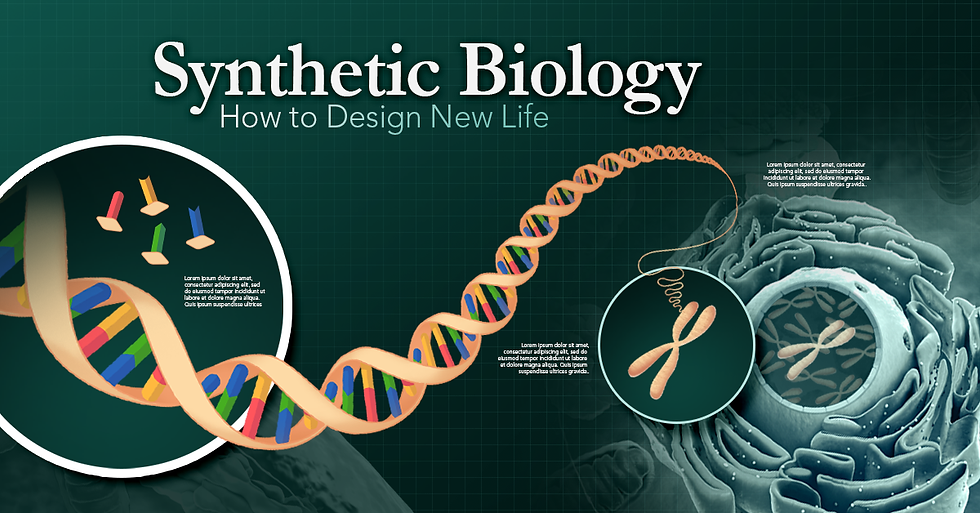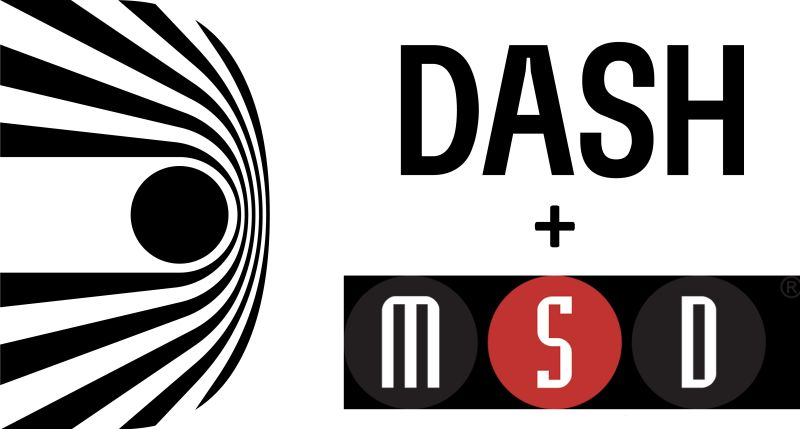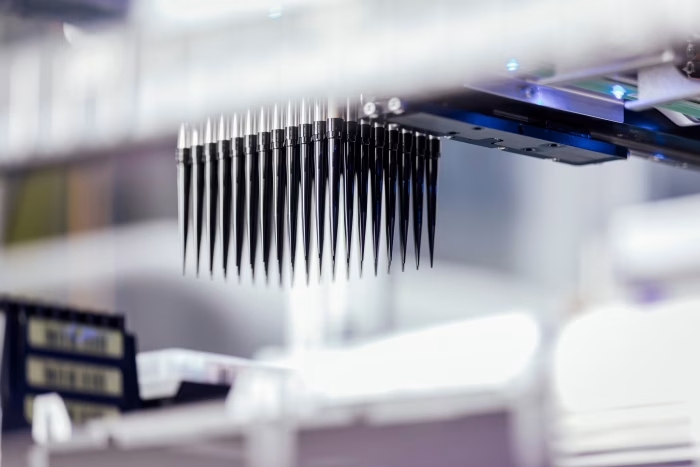How Robotics Startup Dash Bio Is Rewriting the Rules of Synthetic Biology With Intelligent Automation
- Aisha Washington

- Aug 12
- 14 min read

Synthetic biology is undergoing a transformation. At the intersection of biology-as-engineering, robotics, and machine learning sits Dash Bio — a startup building automation-first platforms that promise faster, more reproducible design-build-test cycles for engineered organisms. For researchers, investors, and biotech executives, Dash Bio’s approach matters because it tackles three persistent bottlenecks in modern biodesign: low experimental throughput, poor reproducibility, and the ad-hoc integration of software and hardware. This article synthesizes peer-reviewed research, standards guidance, and market analysis to explain how synthetic biology automation is evolving and where Dash Bio fits in.
The analysis draws on authoritative sources including reproducibility and automation discussions in Nature Methods, market forecasts from Grand View Research, foundational standards activity at NIST, and primary company material from Dash Bio. It also references recent preprints on automated biodesign and modular labs to explain technical trade-offs. Throughout, I note concrete implications and starter actions for R&D leaders who want to pilot automation safely and effectively. Keywords you’ll see throughout include: Dash Bio, synthetic biology automation, AI in synthetic biology, robotics in biotech, and modular laboratory architecture.
1. Background: Synthetic Biology, Market Context, and Why Automation Matters

1.1 What is synthetic biology?
Synthetic biology is the application of engineering principles to biology: designing, constructing, and testing biological parts, systems, and organisms with predictable functions. Rather than treating biology as a series of artisanal experiments, synthetic biology frames biological components (genes, promoters, circuits) as modular parts that can be assembled into larger systems. This design/build/test/learn loop borrows from software and hardware engineering: computational design creates candidates, automation builds and assays them, and analytics inform the next round.
Practical examples include engineered microbes that produce pharmaceuticals, biosensors that detect disease markers, and designer proteins for materials. The promise is predictable, scalable biology, but the reality is still constrained by wet-lab throughput and variability.
Actionable insight: Start lab projects by mapping the design/build/test loop: identify which steps are manual, which are rate-limiting, and which can benefit first from automation (e.g., liquid handling or plate-based assays).
1.2 Market growth and commercial opportunity
The synthetic biology market has grown rapidly and is projected to expand further as more industries—pharma, agriculture, industrial chemistry, and materials—adopt engineered biology. Analysts at Grand View Research report sustained double-digit CAGR forecasts driven by falling DNA synthesis costs, more powerful computational design tools, and growing commercial demand for bio-based alternatives.
For investors and R&D leaders, the takeaway is simple: automation and AI are not optional add-ons; they are enablers for capturing scale economics. Companies that can shorten cycles from months to weeks and convert design iterations into validated products faster will command premium margins and speed-to-market.
Actionable insight: Use market projections to justify pilot budgets—document expected throughput gains and cost-per-assay reductions to build an ROI case for automation investment.
1.3 Why automation and AI are becoming strategic imperatives
Two forces are converging. First, automation in synthetic biology multiplies experimental throughput and reduces human error, directly addressing reproducibility challenges highlighted in the research literature. Second, AI-driven biodesign accelerates ideation by proposing candidates computationally, but those candidates must be validated in the wet lab. The loop becomes exponentially more powerful when AI and automation form a closed-loop workflow: models propose designs, robots build and test them, and results update models.
Recent trend analyses and preprints show growing integration of machine learning with automated experimentation, enabling closed-loop experimentation where algorithms continuously optimize toward targeted phenotypes. For R&D leaders this means shifts in staffing (more data scientists and automation engineers), lab layout (modular, instrument-rich benches), and procurement (platforms that expose APIs for orchestration).
Insight: Treat AI and robotics as complementary. The highest ROI comes when model quality and lab throughput scale together.
Actionable insight: Pilot a single closed-loop experiment (e.g., optimizing expression levels of a pathway) to validate integration costs, turnaround time, and performance uplift before committing to lab-wide automation.
2. Dash Bio: Company Profile, Mission, and Value Proposition

2.1 Dash Bio at a glance
Dash Bio positions itself as an automation-first synthetic biology platform provider focused on integrating robotics, software orchestration, and data management to shorten experimental cycles. The company’s public materials emphasize workflow automation that spans sample prep, library construction, and high-throughput assays, aimed at enterprise biotech teams and research organizations. You can review their offerings and stated mission directly on Dash Bio.
Dash Bio targets customers who need reproducible, scalable experimentation: synthetic biology labs in therapeutics, industrial biotech, and companies building bio-based products.
Actionable insight: If evaluating Dash Bio, map your current top-3 workflow bottlenecks to the vendor’s claimed capabilities (e.g., can their platform reduce hands-on time for cloning, or speed up assay throughput?).
2.2 How Dash Bio differs from incumbents
Traditional labs typically bolt automation onto manual workflows: one-off scripts for liquid handlers, manual sample transfers, and spreadsheets for data tracking. Dash Bio emphasizes a different model: design systems where automation and software orchestration are central from the start. This automation-first stance includes API-driven orchestration, integrated data pipelines, and AI-driven experimental planning.
Contrast that with generic off-the-shelf robotics (which often require custom adapters or manual intervention). Dash Bio advertises end-to-end workflows that reduce integration overhead and provide richer metadata capture for reproducibility and downstream analytics.
Insight: Platforms that bake in orchestration and metadata capture reduce the hidden costs of “automation tax” (time spent gluing systems together).
Actionable insight: When choosing automation vendors, require a demo where they run an end-to-end workflow (from protocol definition to data output) to validate system interoperability, not just isolated instrument performance.
2.3 Dash Bio’s claimed impact: speed, reproducibility, cost reduction
Dash Bio’s public narrative focuses on three quantifiable benefits: faster iteration cycles, higher reproducibility via standardized protocols and metadata, and lower effective cost-per-assay through scale and automation. Industry reporting highlights deployments where organizations reduced manual steps, improved sample traceability, and increased experiment throughput.
For stakeholders, these claims translate into concrete business outcomes: projects finish faster, fewer experiments are repeated due to human error, and time-to-insight shortens. That creates earlier go/no-go decisions and can materially affect pipeline valuations.
Actionable insight: Build a short list of reproducibility metrics (failed runs, assay variance, time-to-result) to measure before and after automation pilot deployments. Use those metrics to quantify ROI.
3. Technical Deep Dive: How AI and Robotics Power Next-Gen Biodesign

3.1 AI-driven biodesign workflows
AI-driven biodesign refers to computational methods—machine learning models, probabilistic models, and optimization algorithms—that propose biological constructs (sequences, pathways, regulatory circuits) targeted for specific functions. Contemporary research demonstrates how model-guided design, when coupled with rapid experimental feedback, can accelerate discovery. Recent preprints on automated biodesign engineering describe frameworks for closed-loop optimization, where algorithms generate candidates and update their priors from experimental data to converge faster on desired phenotypes (example frameworks are available in recent arXiv literature, earlier work also detailed model-driven pipelines).
Key technical elements:
Surrogate models that predict phenotype from sequence or construct features.
Bayesian or active-learning approaches to select the most informative experiments.
Integration layers that translate model outputs into robotic protocols.
Insight: The value of AI grows nonlinearly with the quality and quantity of labeled experimental data; automation is the enabler of that data scale.
Actionable insight: Invest in a minimal data pipeline: standardized sample identifiers, validated assay readouts, and automated logging. This baseline makes model training and closed-loop optimization feasible.
3.2 Robotics hardware and automation platforms
Robotics in biotech ranges from dedicated liquid handlers and plate readers to fully integrated robotic labs. Common hardware approaches include:
Bench-top liquid-handling robots for pipetting precision.
Plate-stackers and incubators for automated culture workflows.
Robotic arms and conveyor systems for physical transfer between instruments.
Fully integrated "lab-in-a-room" systems that coordinate multiple instruments.
General-purpose platforms, like those pioneered by companies such as Opentrons, helped democratize robotics by lowering hardware cost and simplifying protocol programming (Opentrons overview). For enterprise deployments, vendors often combine liquid handling with sealed enclosures, advanced scheduling, and robotic transfer.
Actionable insight: When selecting hardware, prioritize platform openness (APIs) and the vendor’s ecosystem (tips, labware definitions). Closed black-box systems can slow integration with AI and orchestration software.
3.3 Software orchestration and modular architecture
Orchestration software is the glue that connects models to instruments. Modular laboratory architecture separates concerns: instrument control modules, protocol definitions, data ingestion pipelines, and experimental schedulers. Modular architectures improve reproducibility because each module can be versioned, tested, and redeployed.
Recent research on modular architectures argues for standardized interfaces and protocol descriptors so that workflows can be ported across labs and instruments (see modular lab architecture research). For example, a sequence-design model exports a plate map and reagent list; orchestration software compiles that specification into instrument commands and a run plan; instruments execute and stream data back to the database.
Insight: Modular orchestration reduces integration time by enabling instrument-agnostic protocol definitions.
Actionable insight: Define an internal protocol schema (fields for reagent lot, tip type, run ID, operator) and require new instruments to map to that schema before procurement.
3.4 Validation and model interpretability
Algorithmic predictions must be tied to wet-lab validation. The literature repeatedly emphasizes reproducibility and the need for interpretable models; blind reliance on black-box outputs risks wasted experiments or hidden biases (Nature Methods discusses reproducibility and automation). Practical validation steps include replicate experiments, orthogonal assays, and controlled benchmarks.
Model interpretability in biology is about connecting model features to known mechanisms (e.g., motifs, codon usage, structural features). Even partial interpretability can guide smarter experiments—selecting designs that test mechanistic hypotheses in addition to improving performance.
Actionable insight: Pair AI-driven candidate lists with a validation matrix: primary assay, orthogonal confirmation, and replicate plan. Require that at least one orthogonal assay be included for every model-driven campaign.
4. Lab Design & Modular Architectures: Building the Automated Lab

4.1 The rise of modular lab architecture: benefits for scale and flexibility
Modular laboratory architecture treats the lab as a collection of interoperable modules—sample prep, liquid handling, incubation, analytics—connected by defined interfaces. This approach enables:
Reconfigurability: swap or upgrade modules without redesigning the entire workflow.
Parallelization: run multiple campaigns using shared modules.
Standardization: enforce protocol and metadata standards across modules.
Research on modular architectures highlights interoperability and standardized protocol descriptors as key enablers for scale (modular lab architecture research). For organizations, modular design reduces vendor lock-in and allows incremental automation.
Insight: Modular labs make automation investments evolvable rather than terminal.
Actionable insight: Start with a pilot module (e.g., automated plasmid prep or plate-based screening) designed to plug into existing lab space and integrate with orchestration software.
4.2 Robotics platforms and integration examples
Smaller, general-purpose platforms like Opentrons showed that affordable robotics could democratize repetitive tasks, making automation accessible to academic labs and startups (Opentrons overview). In larger deployments, multiple robotic brands are integrated via software layers that handle scheduling, error recovery, and data capture.
Integration requires more than hardware compatibility: lab managers must define standard labware, calibrate between devices, and implement quality-control routines. Successful integrations include custom adapters, shared barcode systems, and facility-level connectivity.
Actionable insight: Require a standard labware registry and barcode-based sample tracking as part of any integration plan. This reduces manual transcription errors and simplifies reconciliation across modules.
4.3 Scaling throughput while preserving reproducibility
Scale often magnifies small sources of variability. To preserve reproducibility while scaling:
Automate repetitive liquid-handling steps to reduce human pipetting variance.
Use instrument qualification procedures and scheduled calibration.
Capture comprehensive metadata: lot numbers, timestamps, operator IDs.
Implement automated QC checks and early-fail detection in pipelines.
The literature reinforces that reproducibility is not automatic with automation; it requires protocol rigor and metadata discipline (Nature Methods on reproducibility). Dash Bio and similar platforms prioritize metadata capture and protocol versioning to ensure experiments can be audited and re-run.
Actionable insight: Implement a run-acceptance checklist (calibration, reagent QC, labware checks) that must pass before automated campaigns begin. Track acceptance metrics over time to detect drift.
5. Case Studies & Current Applications

5.1 Opentrons: robotics democratizing synthetic biology workflows
Opentrons is a visible example of how accessible robotics can change everyday lab practice. Their platforms enable labs to automate pipetting workflows that historically required specialized, expensive equipment. Typical use cases include PCR setup, ELISAs, plasmid preps, and routine high-throughput screening. Accessibility led to adoption in teaching labs, startups, and academic core facilities, demonstrating how lower-cost automation can unlock experimentation scale.
Actionable insight: For groups with limited budgets, consider a hybrid approach: deploy a general-purpose robot for high-volume pipetting while outsourcing specialized assays to a partner facility.
5.2 Dash Bio in practice: reported breakthroughs and deployment scenarios
Industry reporting describes Dash Bio as applying automation to workflows such as library construction, transformation pipelines, and screening assays. In deployed scenarios, Dash Bio’s platform reportedly reduces hands-on time and centralizes protocol logic, improving reproducibility and easing auditing for regulated projects. Their approach is marketed for enterprise R&D environments where consistency across sites and teams matters.
Case scenarios include:
Pharmaceutical R&D accelerating early lead optimization.
Industrial biotech teams scaling enzyme screens for bioprocess improvements.
Startups using automation to generate stronger preclinical data faster.
Actionable insight: When considering a commercial platform like Dash Bio, require a defined proof-of-concept (POC) scope with success criteria (e.g., % reduction in hands-on time, improvement in assay CV) to avoid vague procurement outcomes. See company materials at Dash Bio.
5.3 Biological robots and emerging applications
Beyond traditional automation, biological robots—self-actuating biological systems or engineered organisms that perform mechanical or sensing tasks—are emerging research areas. Preprints explore microrobots and programmable materials with embedded biological components (research on biological robots). In practice, robotics in biotech is also producing hybrid applications: automated platforms for cell therapy manufacturing, diagnostics that integrate sample prep and detection, and accelerated material discovery workflows.
Actionable insight: For R&D teams exploring frontier applications, budget small exploratory projects to assess feasibility; use modular automation to pivot quickly between biological robot development and standard assay workflows.
6. Data, Market Trends, and Quantitative Drivers

6.1 Key statistics: market growth, automation adoption rates, and investment trends
Market analyses indicate robust growth for synthetic biology, driven by demand for bio-based products and advances in tools and automation. Grand View Research reports significant CAGR forecasts across segments. Adoption of robotics in biotech has accelerated, with analysts documenting rising procurement and capital investment in lab automation platforms (see industry statistics and adoption dashboards such as those compiled in sector reports and market data portals).
Institutional investors are increasingly funding automation-native startups and synthetic biology companies that can demonstrate rapid iteration velocity and reproducible outcomes. Higher valuations cluster around teams that combine wet-lab expertise with software and automation capabilities.
Actionable insight: Use publicly available market projections to benchmark internal business cases for automation; align KPI targets (throughput, cost per data point) with investor expectations.
6.2 Industry analyses and forward-looking trend reports
Industry trend reports emphasize the convergence of AI and automation as the next major inflection point. Analysts forecast that AI-native lab design, coupled with automation, will shorten R&D timelines and reduce the number of necessary experimental iterations. Reports suggest demand for modular lab setups and integrated orchestration software that can support multi-site deployments and regulatory traceability.
Actionable insight: Include AI-integration readiness as a procurement criterion for new instruments: does the vendor expose APIs for data streaming, and can their protocols be programmatically generated?
6.3 Evidence of ROI: throughput, cost-per-assay, and reproducibility metrics
Empirical evidence for ROI typically centers on:
Increased throughput: more designs tested per unit time.
Lower cost-per-assay: reduced labor and reagent waste through precise dispensing.
Improved reproducibility: lower coefficient of variation across replicates and fewer failed runs.
Reproducibility discussions in Nature Methods and industry resources highlight that realized ROI depends on implementation quality: poor calibration or inadequate metadata capture can erode expected gains. Platforms that prioritize QC and metadata capture tend to deliver measurable ROI.
Actionable insight: Define a baseline for ROI measurement before pilot roll-out—capture current cost per assay, manual labor hours per campaign, and reproducibility metrics to quantify post-automation improvements.
7. Challenges, Standards, and Solutions

7.1 Technical and biological challenges
Adopting automation in synthetic biology introduces technical and biological challenges:
Complexity: biological systems are context-dependent; small changes can have outsized effects.
Data quality: noisy assays and inconsistent metadata undermine model training.
Model validation: AI proposals require rigorous wet-lab verification to avoid false positives and overfitting.
Recent preprints and reviews point to these limits and propose robust experimental design and active learning strategies to mitigate them (automated biodesign literature, earlier frameworks).
Actionable insight: Treat automation adoption as a data-quality program as much as an engineering program: enforce standardized assays, calibration schedules, and metadata capture from day one.
7.2 Standards, reproducibility, and regulatory alignment
Standards bodies like NIST are active in shaping reproducibility standards, measurement protocols, and benchmarking frameworks for synthetic biology. Aligning with standards assists with regulatory readiness and improves cross-lab reproducibility. For regulated sectors (therapeutics, diagnostics), audit trails and validated workflows are prerequisites.
Insight: Standards-compliant workflows lower regulatory friction and increase the credibility of automated data.
Actionable insight: Engage with standards guidance (e.g., NIST recommendations) early in pilot design, and design data models that can export standard audit artifacts for compliance purposes.
7.3 Solutions and best practices
Practical mitigation strategies include:
Modular architectures to limit system-wide disruption when upgrading instruments (modular lab research).
Interdisciplinary teams combining biologists, automation engineers, and data scientists.
Partnerships with vendors and standards bodies to accelerate validation and troubleshooting.
Operational best practices: 1. Start with focused pilots that have clear, measurable endpoints. 2. Build a reproducibility playbook: protocol versioning, calibration logs, and run acceptance criteria. 3. Institutionalize data hygiene: unique sample IDs, reagent lot tracking, and timestamped metadata.
Actionable insight: Require that pilot budgets include staff time for protocol standardization and metadata engineering—these are often the hidden drivers of long-term success.
8. FAQ
Q1: What exactly does Dash Bio automate, and how is it different from off-the-shelf robots? A: Dash Bio focuses on end-to-end workflow automation—combining protocol orchestration, data capture, and instrument control to deliver reproducible pipelines. Off-the-shelf robots (for example, Opentrons) provide instrument capability but often require substantial integration work to become part of a reproducible, multi-step pipeline. Dash Bio emphasizes automation-first design and orchestration to reduce that integration burden. See Dash Bio for vendor-specific capabilities.
Q2: How reliable are AI-designed biological constructs in practice? A: AI-generated designs can be powerful but are not guaranteed to work without wet-lab validation. The current best practice is closed-loop experimentation: models propose candidates, automated labs test them, and results refine models. Reproducibility literature in Nature Methods and recent preprints on automated biodesign (see arXiv preprints) stress the need for orthogonal assays and replication to build trust in AI-generated constructs.
Q3: Are there standards or regulatory frameworks for automated synthetic biology? A: Standards work is underway. Organizations such as NIST publish measurement standards and guidance that help align automated workflows with reproducibility and regulatory expectations. Adopting standards early simplifies later regulatory interactions and audits.
Q4: What kinds of labs or organizations benefit most from this approach? A: Organizations with high-throughput needs and repetitive assay workflows derive the most immediate benefit: pharmaceutical lead optimization teams, industrial enzyme screening groups, and startups seeking rapid iteration. Market analyses from Grand View Research show demand across sectors, but the scale and capital requirements vary.
Q5: How should teams start integrating automation and AI safely? A: Begin with a narrowly scoped pilot that has clear success metrics. Prioritize data hygiene: standardized sample IDs, reagent lot tracking, and automated metadata capture. Partner with vendors who can demonstrate orchestrated end-to-end workflows and consult standards guidance such as Bio.org’s automation resources for best practices.
Q6: Will automation eliminate lab jobs? A: Automation changes job composition rather than eliminating roles wholesale. Routine manual tasks decline, while demand rises for staff skilled in protocol design, automation maintenance, and data analysis. Upskilling and cross-training are recommended investments.
Q7: Can small academic labs realistically adopt these platforms? A: Yes—affordable, general-purpose robots lowered the entry barrier. However, to realize the full benefits of AI-driven closed-loop workflows, investment in data infrastructure and protocol standardization is required. Hybrid approaches (in-house robots + external partnerships) are practical first steps.
9. Actionable Conclusions & Forward-Looking Analysis
9.1 Key takeaways
Dash Bio sits at the convergence of robotics, software orchestration, and AI-driven biodesign, offering automation-first workflows that can shorten design-build-test cycles. See Dash Bio for platform details.
Automation and AI are mutually reinforcing: AI requires large, high-quality datasets that automation can produce; automation needs intelligent experimental design to maximize value.
Standards and reproducibility matter: Aligning with guidance from organizations such as NIST and the reproducibility frameworks discussed in Nature Methods reduces risk and speeds regulatory readiness.
Market momentum supports investment: Analysts at Grand View Research forecast continued growth, making automation investments strategically important.
9.2 Practical next steps for stakeholders
For R&D leaders:
Run a focused automation pilot with defined metrics (throughput, CV, hands-on time reduction).
Build a cross-functional team (biologists, automation engineers, data scientists). For investors:
Prioritize companies that demonstrate integrated AI/automation and clear reproducibility metrics. For policy makers:
Support standards and benchmarking efforts to facilitate interoperability and safe scaling (engage with NIST).
Actionable steps: Define a 90-day pilot plan that includes scope, success metrics, vendor evaluation criteria (API access, metadata capture), and a budget line for protocol standardization.
9.3 Forward-looking research & business opportunities
Promising directions include:
AI-native lab design: platforms that generate instrument-ready protocols directly from models.
Biological robots: hybrid systems where engineered organisms perform sensing or actuation tasks, coupled with robotic fabrication for materials.
Cross-disciplinary talent: demand for professionals fluent in biology and automation will grow rapidly.
Research preprints on biological robots and automated biodesign (see arXiv research, 2404.18973) signal fertile ground for startups and strategic R&D investments.
Final insight: The combination of robotics in biotech, AI in synthetic biology, and modular laboratory architecture is reshaping how biological products are designed and validated. Organizations that treat automation as a strategic competency — not just an instrument purchase — will capture disproportionate value in the coming decade.
Bold takeaway: Invest in modular automation pilots, enforce rigorous metadata practices, and couple AI with wet-lab validation to turn synthetic biology dreams into reproducible, investable outcomes.

